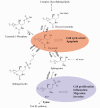Sphingolipid regulation of ezrin, radixin, and moesin proteins family: implications for cell dynamics
- PMID: 23850862
- PMCID: PMC3888837
- DOI: 10.1016/j.bbalip.2013.07.002
Sphingolipid regulation of ezrin, radixin, and moesin proteins family: implications for cell dynamics
Abstract
A key but poorly studied domain of sphingolipid functions encompasses endocytosis, exocytosis, cellular trafficking, and cell movement. Recently, the ezrin, radixin and moesin (ERM) family of proteins emerged as novel potent targets regulated by sphingolipids. ERMs are structural proteins linking the actin cytoskeleton to the plasma membrane, also forming a scaffold for signaling pathways that are used for cell proliferation, migration and invasion, and cell division. Opposing functions of the bioactive sphingolipid ceramide and sphingosine-1-phosphate (S1P), contribute to ERM regulation. S1P robustly activates whereas ceramide potently deactivates ERM via phosphorylation/dephosphorylation, respectively. This recent dimension of cytoskeletal regulation by sphingolipids opens up new avenues to target cell dynamics, and provides further understanding of some of the unexplained biological effects mediated by sphingolipids. In addition, these studies are providing novel inroads into defining basic mechanisms of regulation and action of bioactive sphingolipids. This review describes the current understanding of sphingolipid regulation of the cytoskeleton, it also describes the biologies in which ERM proteins have been involved, and finally how these two large fields have started to converge. This article is part of a Special Issue entitled New Frontiers in Sphingolipid Biology.
Keywords: Ceramide; Ezrin; Moesin; Radixin; Sphingolipids; Sphingosine-1-phosphate.
© 2013. Published by Elsevier B.V. All rights reserved.
Figures


Similar articles
-
Sphingosine 1-phosphate-mediated activation of ezrin-radixin-moesin proteins contributes to cytoskeletal remodeling and changes of membrane properties in epithelial otic vesicle progenitors.Biochim Biophys Acta Mol Cell Res. 2019 Apr;1866(4):554-565. doi: 10.1016/j.bbamcr.2018.12.007. Epub 2019 Jan 3. Biochim Biophys Acta Mol Cell Res. 2019. PMID: 30611767
-
Differential involvement of ezrin/radixin/moesin proteins in sphingosine 1-phosphate-induced human pulmonary endothelial cell barrier enhancement.Cell Signal. 2011 Dec;23(12):2086-96. doi: 10.1016/j.cellsig.2011.08.003. Epub 2011 Aug 12. Cell Signal. 2011. PMID: 21864676 Free PMC article.
-
Intracellular sphingosine kinase 2-derived sphingosine-1-phosphate mediates epidermal growth factor-induced ezrin-radixin-moesin phosphorylation and cancer cell invasion.FASEB J. 2015 Nov;29(11):4654-69. doi: 10.1096/fj.15-274340. Epub 2015 Jul 24. FASEB J. 2015. PMID: 26209696 Free PMC article.
-
CLIC proteins, ezrin, radixin, moesin and the coupling of membranes to the actin cytoskeleton: a smoking gun?Biochim Biophys Acta. 2014 Feb;1838(2):643-57. doi: 10.1016/j.bbamem.2013.05.025. Epub 2013 Jun 1. Biochim Biophys Acta. 2014. PMID: 23732235 Review.
-
The ezrin-radixin-moesin family of proteins in the regulation of B-cell immune response.Crit Rev Immunol. 2015;35(1):15-31. doi: 10.1615/critrevimmunol.2015012327. Crit Rev Immunol. 2015. PMID: 25746045 Free PMC article. Review.
Cited by
-
Sphingolipids in neurodegeneration (with focus on ceramide and S1P).Adv Biol Regul. 2018 Dec;70:51-64. doi: 10.1016/j.jbior.2018.09.013. Epub 2018 Sep 22. Adv Biol Regul. 2018. PMID: 30287225 Free PMC article. Review.
-
Ceramides in Parkinson's Disease: From Recent Evidence to New Hypotheses.Front Neurosci. 2019 Apr 2;13:330. doi: 10.3389/fnins.2019.00330. eCollection 2019. Front Neurosci. 2019. PMID: 31001082 Free PMC article. Review.
-
Intracellular Theileria annulata promote invasive cell motility through kinase regulation of the host actin cytoskeleton.PLoS Pathog. 2014 Mar 13;10(3):e1004003. doi: 10.1371/journal.ppat.1004003. eCollection 2014 Mar. PLoS Pathog. 2014. PMID: 24626571 Free PMC article.
-
Ezrin Is Associated with Disease Progression in Ovarian Carcinoma.PLoS One. 2016 Sep 13;11(9):e0162502. doi: 10.1371/journal.pone.0162502. eCollection 2016. PLoS One. 2016. PMID: 27622508 Free PMC article.
-
Ceramide as a Target of Marine Triterpene Glycosides for Treatment of Human Myeloid Leukemia.Mar Drugs. 2016 Nov 3;14(11):205. doi: 10.3390/md14110205. Mar Drugs. 2016. PMID: 27827870 Free PMC article. Review.
References
-
- Hannun YA, Obeid LM. Principles of bioactive lipid signalling: lessons from sphingolipids. Nature reviews. Molecular cell biology. 2008;9:139–150. - PubMed
-
- Bretscher A, Edwards K, Fehon RG. ERM proteins and merlin: integrators at the cell cortex. Nature reviews. Molecular cell biology. 2002;3:586–599. - PubMed
-
- Tsukita S, Yonemura S. ERM (ezrin/radixin/moesin) family: from cytoskeleton to signal transduction. Current opinion in cell biology. 1997;9:70–75. - PubMed
Publication types
MeSH terms
Substances
Grants and funding
LinkOut - more resources
Full Text Sources
Other Literature Sources
Research Materials

